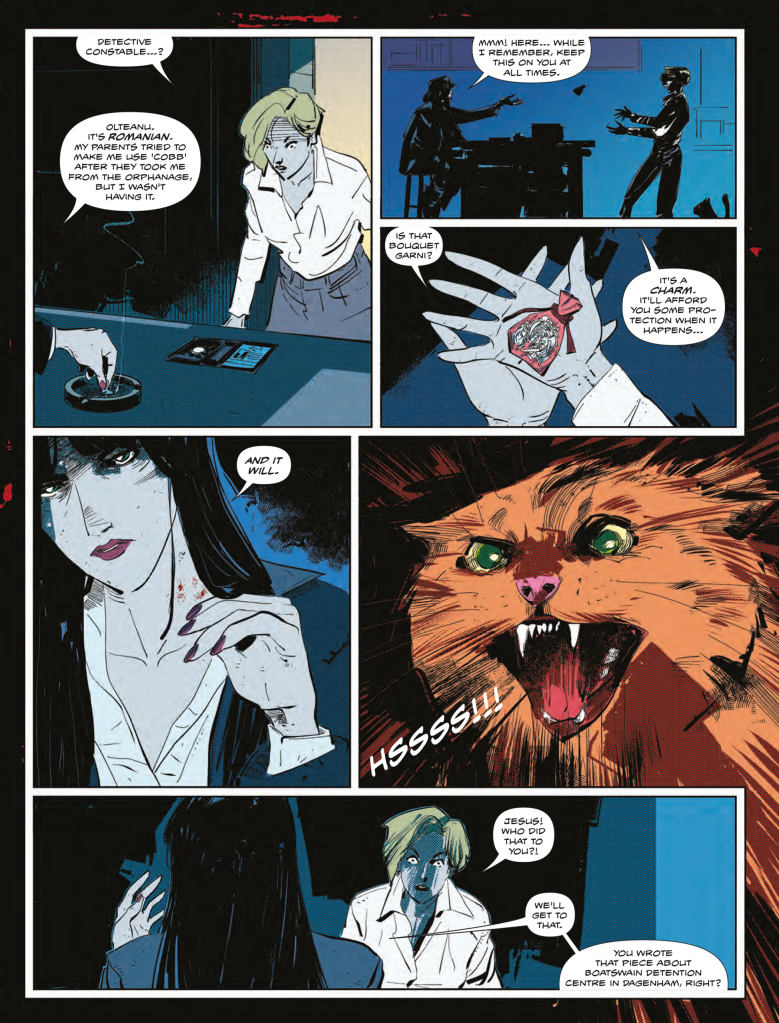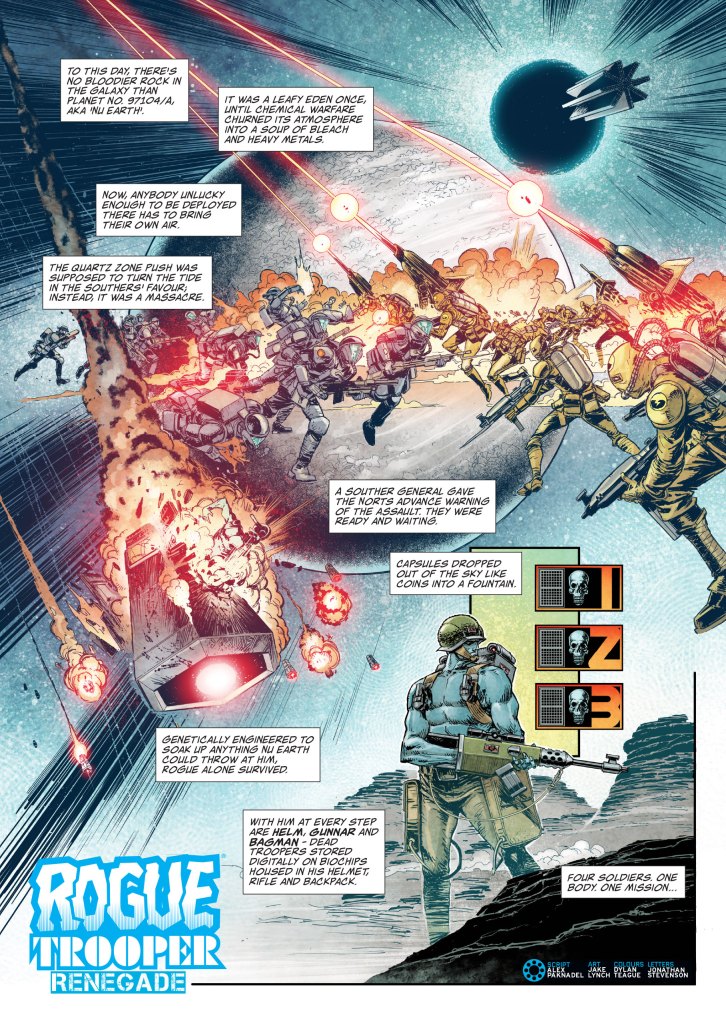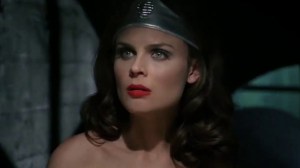Alex Pankadel has some thoughts about Dracula. Those thoughts have mostly gone into his revival of The Dracula File — Gerry Finley-Day, Simon Furman, and Eric Bradbury’s original Scream! strip that imagined Count Dracula fleeing the Eastern Bloc for the more hospital climate in the United Kingdom in the 1980s — for Rebellion Publishing’s celebration of the short-lived Scream! horror anthology, Scream! 40th Anniversary Special. Answering questions from ComicBook, Paknadel dove deep into what he sees as Dracula’s influence dating back to Romanian folklore and guest-host etiquette before explaining how he — along with his collaborators: artist Alejandro Aragon, colorist Jason Wordie, and letterer Jonathan Stevenson — modernized The Dracula File further to more subtle and sinister ends.
Videos by ComicBook.com
But The Dracula File isn’t the only Finley-Day co-creation that Paknadel will add his voice to this year. He’s also teaming with artist Jake Lynch on a Rogue Trooper story in 2000 AD Annual 2025.

What are your thoughts on Dracula, generally speaking? What value remains in this character that is now over a century old? Was it challenging to get a unique handle on a character that has been thoroughly put through the pop culture wringer?
My thoughts on Dracula are a bit unfocused, to be honest – not least because I think the character itself is unfocused and quite radically unstable – but for me that only makes him more compelling.
The historical Vlad Tepes remains a Romanian national hero, whereas the strigoi of Romanian folklore is a drifter, and anything but aristocratic. Like the werewolf, the vampire is a manifestation of an anxiety over feudal hospitality customs that predated the rule of law. Back in the dark ages, the obligation on hosts to provide protection and shelter to travelers was absolute – but of course, on very rare occasions a bad guest might abuse the relationship. The vampire is that abusive guest dialed up to eleven, literally draining the life from its host(s) – hence the literary device of the vampire requiring an invitation to cross the threshold of a dwelling.
[RELATED: Garth Ennis Talks Rogue Trooper, Johnny Red, & His 2000 AD Christmas Story]
However, in many cases – and I think you can see this very clearly in An American Werewolf in London – the werewolf is an embodiment of that anxiety in reverse. If you turn a guest out into the night without offering them protection, they might fall prey to the wilderness and plague the community forevermore. What’s really at stake here is the Homeric idea of xenia or hospitality. Bestowing or denying it can have terrible consequences according to folkloric sources.
Now, Stoker’s Count Dracula – inspired by Polidori’s Vampyr, no doubt – blasts this formulation apart in many ways. The Eastern European and Slavic vampire is a drifter, and in some instances the returned dead. But Stoker, like Polidori, made the vampire an aristocrat – a host rather than a guest. As a depraved host, Dracula repositions the vampire as a figure of upper-class parasitism, draining the lower orders of their vital essence to prolong his unnaturally long life.
That reversal, I believe, is key to the character’s enduring appeal. He came to prominence at the tail end of the Industrial Revolution, where the upper classes and the robber barons had made it abundantly clear that the poor, and to the lesser extent the middle class, were resources to be depleted and discarded. Dracula is that rapacious, dehumanizing appetite made flesh.

In that vein, what about The Dracula File‘s specific take on Dracula attracted you toward writing a story in the same mold?
For my money, what Finley-Day, Furman, and Bradbury created was almost as radical in its approach as Stoker’s novel. The Cold War was arguably at its hottest when the strip was made, and Romanian dictator Nicolae Ceaușescu’s televised execution was still six years away. The idea of Dracula, the ultimate aristocrat, violently defecting to the West, is breathtakingly inspired. That said, Dracula’s rampage across London, pitting him against the British police and security services, always felt like a half-defection to me.
Reading those original strips, I was suddenly struck by the horrific notion that given enough time, Dracula might find a way to ingratiate himself with the British establishment – that they might even learn to embrace him if he proved useful to them. It gave me an opportunity to explore what the great Hannah Arendt termed ‘the banality of evil’, and to do it with arguably the most over-the-top, caricatured pantomime villain in history. This is a Dracula story where the real villains don’t have fangs; instead, they just leave the door unlocked for something that does.

What can you tell me about collaborating with Alejandro Aragon on this story? It’s a gorgeous story with a horror genre atmosphere, but not the gothic horror traditionally associated with Dracula.
I asked for Alejandro and our wonderful colorist Jason Wordie right off the bat because I knew they’d deliver something just as visceral and uncompromising as the strips that came before, but in a scratchier and more unsettling style. Ale employs a very loose, impressionistic line, but somehow, he never loses a single nuance of human emotion. You can tell what his characters are thinking at a glance. It’s quite remarkable.
As for Jason, I think his somewhat flatter palette complements Ale’s liberal use of half-tone, which I adore. In terms of craft and just elegant storytelling, there is no better team for this story. I won the lottery here.

Switching gears, you and artist Jake Lynch also have a Rogue Trooper story coming out in November’s 2000 AD Annual 2025. What can you tell me about that story and your and Jake’s take on one of 2000 AD‘s most iconic characters?
Not much, but I can tell you it’s set just after ‘All Hell on the Dix-I Front’, it’s about a shortcut through a psychedelic swamp, and it’s absolutely stunning to look at thanks to Jake.
The most basic storytelling hack you’re given when they hand you a ballpoint pen and a notebook is “confront your protagonist with their opposite”, and that’s pretty much all I’ve done here. I’ve tried to do it in that bleakly humorous 2000 AD way, and it’s not without its grisly aspects either, but in the main, I just tried to write something with this thrill-power I’ve heard so much about. I wasn’t a 2000 AD kid growing up, but I’ve grown to love it as an adult so it’s very, very exciting to be playing in this sandbox at this point in my career.

For fans who maybe know you from other work but are less familiar with 2000 AD and Scream! (or perhaps vice versa), are there particular themes or other elements that you’ll think they’ll find familiar between these stories and your work on titles such as Sentinels, All Against All, etc.?
I hope this doesn’t come across as performatively edgy or whatever, but I suppose my work is characterized by an abiding fear of losing my/our humanity. Crises – and we’re facing a few of them now – repeatedly call on us to choose between the right thing and the easy thing. The easy thing might bring us comfort and even less risk in the short term, but our humanity is never a given.
Every time we make that easy choice – to turn away the guest in need, to make deals with the devil – we give some of it away. I’m not for one second claiming to be a paragon of virtue of course, but if I think about it long and hard I suppose the theme I always come back to is the willing dehumanization of the self. The horror of that.

Scream! 40th Anniversary Special is already on sale in the U.K. and will be released in the United States on December 11th. 2000 AD Annual 2025 goes on sale on November 27th.








